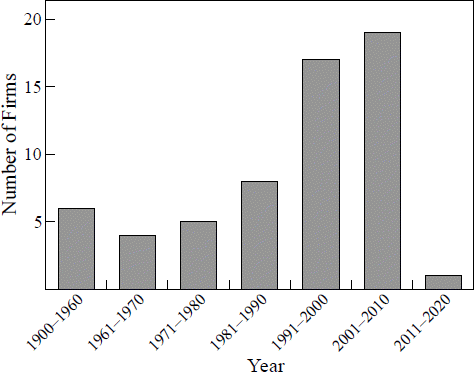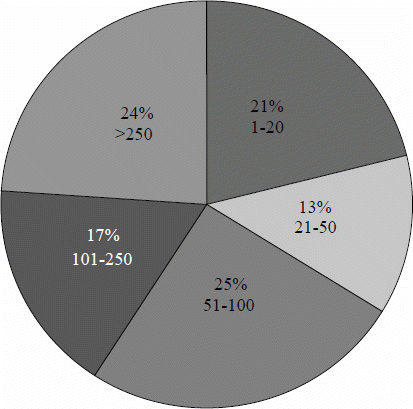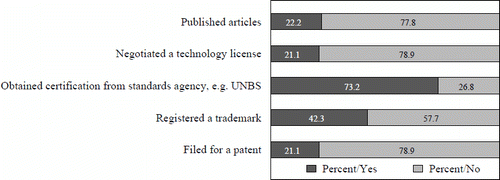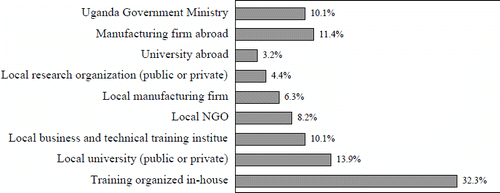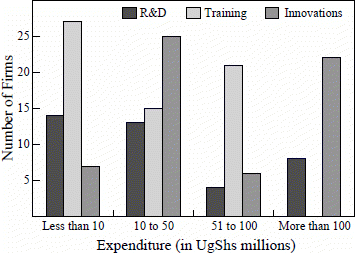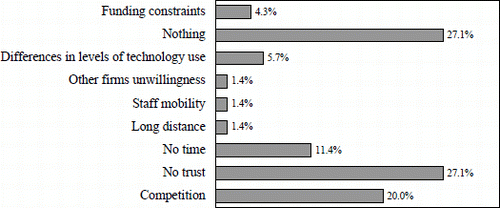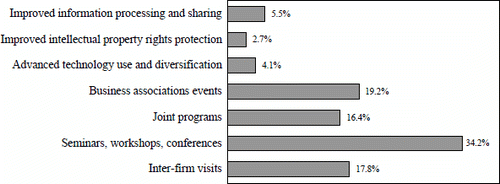Abstract
Manufacturing firms ought to innovate in order to stay competitive in a highly liberalised and open economy. This is even more crucial in low income countries, which seek accelerated economic growth and transformation. In this paper, we describe innovation characteristics of formal manufacturing firms in Uganda, in the subsectors of food and beverages, chemicals and pharmaceuticals. We show from empirical findings that formal manufacturing firms in the aforementioned subsectors in Uganda are active in incremental and adaptive innovations. The innovations are accomplished in-house with some assistance from other firms abroad. Local universities and research organisations appear not to be participating much in formal manufacturing firms' innovation processes. The challenge, from the perspective of firms, is fear of competition and lack of trust. Universities and research organisations, on the other hand, need to be proactive in engaging firms. Conferences, business associations, inter-firm visits, and joint programmes are some of the firm-preferred means of fostering interactions between firms, universities and other organisations. Innovation capabilities of Ugandan manufacturing firms could be enhanced if local universities and research organisations become more actively involved in firm innovation processes.
Introduction
Manufacturing is one of the ways of promoting value addition and agro-processing. The latter is vital for increasing household incomes of the majority of Ugandans, who engage predominantly in primary agricultural production. However, growth in manufacturing generally has not only been slow, but has also been declining in the past few years (Ministry of Finance Planning and Economic Development, MFPED Citation2012). The World Bank reports a slump in manufacturing from 13.8% in the 1990s to 6.6% in the 2000s. It further observes that the contribution of manufacturing to Uganda's GDP has remained stagnant at 7.4% in the last two decades (World Bank Citation2012). This slow growth in manufacturing is partly attributed to electricity shortage and fluctuation of the foreign exchange rate. And yet, Ugandan manufacturing firms are increasingly challenged to be more innovative and competitive (MFPED Citation2010) in the regional and international market. Markets are also becoming more and more liberalised.
Efforts to enhance the competitiveness of Uganda's private sector have so far focused largely on regulatory reforms to ease doing business, provision of infrastructure and incentives to attract foreign direct investments. These efforts, inter alia, include creation of dedicated organisations like the Private Sector Foundation, Uganda Investment Authority and Uganda Export Promotions Board. They also include initiatives such as the Competitiveness and Investment Climate Strategy of the Ministry of Finance, Planning and Economic Development and the annual Presidential Investors' Round Table. These initiatives have a common goal of improving Uganda's business environment and competitiveness in the region and internationally. The efforts notwithstanding, Uganda continues to rank poorly in the global competitiveness index, and real growth in the manufacturing sector remains low (World Bank Citation2012, Bbaale Citation2011). Achieving higher levels of competitiveness will require sustained and consistent support to the aforementioned initiatives and efforts. More importantly, it requires deliberate measures to build innovation competences of Ugandan manufacturing firms.
Innovations are new ideas or practices or new or improved goods and services introduced in society (Lundvall Citation2007, Witt Citation2002, Rogers Citation2003). Depending on their attributes, innovations can be broadly categorised as product, process and organisational innovations (Edquist Citation2001). Furthermore, an innovation could be radical (i.e. new to the world) or incremental in nature (Freeman Citation1995, Oyeleran-Oyeyinka et al. Citation1996). Innovation is critical to a firm's growth and competitiveness (World Economic Forum Citation2010). It is an outcome of interactive learning among and between diverse actors (Lundvall Citation2010, Adebowale and Oyeleran-Oyeyinka Citation2012). This paper highlights the characteristics of innovation in formal manufacturing firms in Uganda – one quarter of the manufacturing sector in Uganda is informal (MFPED 2012). The paper is based on an exploratory study conducted in the year 2011/12 among formal manufacturing firms in the food and beverages, chemicals and pharmaceuticals sub-sectors. These sub-sectors represent the primary production sectors, which closely address Uganda's quest for value addition, agro-processing and agribusiness.
The aim of the paper is to highlight the important characteristics of firm innovation, including firms' nature of interaction and learning. While there is a growing body of literature on firm innovations elsewhere, empirical data on innovations in manufacturing firms of Uganda is insufficient. In this paper, it is considered innovation if a firm makes significant improvements in its products, or introduces a new product or makes changes in its management or organisational system. It is also an innovation if a firm makes improvements in its methods of manufacturing, delivering inputs, packaging and distributing goods. Firm interactions and learning are assessed by parameters such as people (or organisations) who collaborated with the firm in the innovation process, where the firm acquired its technologies and scientific and technical information, and the firm's participation in networking events. Other characteristics such as firm size, age, ownership, training, spending on research, and student internships are also taken into account.
Method
Study population and sample size
The study was conducted in the year 2011/2012 among Ugandan formal manufacturing firms, drawn from three subsectors: foods and beverages, chemicals, and pharmaceuticals. The firms were selected from the 2010/2011 Uganda Manufacturers' Association (UMA) membership directorate, which was taken as the sampling frame for the study. UMA is the umbrella organisation for manufacturers in Uganda. It has a membership of over 80% of formal manufacturing firms in the country.
A list of 289 eligible firms was generated from the UMA directorate comprising firms in the foods and beverages (134), chemicals (46), and pharmaceuticals (9) sub-sectors. A sample size of 165 firms was calculated using Krejcie and Morgan's (Citation1970) formula for determination of sample size:

where s = desired sample size, χ2 = 3.84, which is the table value of the Chi-square at d.f. = 1 for a 5% confidence level, N = population size, P = population proportion (assumed to be 0.5) and d = degree of accuracy (0.05).
Data collection
Questionnaires were investigator-administered to the extent possible. Most of the respondents, however, preferred completing the questionnaires by themselves (self-administration). All respondents were senior officers of firms holding a managerial or supervisory position, such as production manager or managing director. Of the 165 firms randomly selected, only 109 were traceable and could be visited. Of the 109 firms 71 responded to the questionnaires. Firms which could not be reached and those that refused or did not respond to the questionnaire were all treated as non-respondents, thus giving a 43% response rate. The questionnaire covered firm characteristics, innovation processes, research and development (R&D) expenditure and sources, human resource training, collaboration and networking, constraints to firm interactions, and recommendations for enhancing collaboration and cooperation.
Data analysis
Data were entered in Epidata software version 3.1 and analysed using SPSS Statistics 17.0 computer software. The next section presents the results.
Results
Firms' characteristics
Formal manufacturing firms which completed the questionnaire were, by subsector: food and beverages (58%), chemicals (35%) and pharmaceuticals (7%). These firms were relatively young, with nearly two thirds (62%) of them being less than 25 years old (). Most firms were established either by individuals (39%), by a group of people (38%) or by a group of companies (18%). Firms established by Government were few (4%). No firm was established by a local research organisation or university. shows the firm sizes according to number of employees (OECD Citation2005 Oslo Manual, para. 249). No significant association was observed between firm size and firm innovations in the last three years ().
Table 1: Relationship between firm innovation and firm size, expenditure on training and research
Firm innovations
Innovation by a firm was determined by the firm's significant improvements to products or the introduction of new products (product innovation), or changes in management system (organisational innovation) and changes in methods of manufacturing, delivering inputs, packaging and distributing products (process innovation). On average, more than 60% of the firms had innovated in the previous three years (). Improvements in products were mainly to quality (39%) and packaging (22%), although to a small extent improvements were also made to increase quantity (7%) as well as branding (6%) of the products. This is illustrated further in . Nearly three quarters (73%) of the firms had obtained quality marks and had registered trademarks. No more than one quarter of the firms filed for a patent or negotiated a technology license.
Firm interactions
A wide range of people and organisations were involved in the firms' innovative activities. Involvement of people and organisations is an important indication of a firm's interaction with other actors. A firm's source of technology acquisition, sources of scientific and technical information, and participation in networking events are other indicators of the firm's interaction. Overall, firms innovated using internal expertise and assistance from other firms abroad (). Local universities and research organisations did not participate much in the firms' innovative activities in the period covered by the study. Firms, however, collaborated with government regulatory agencies, notably Uganda National Bureau of Standards, National Environment Management Authority, Dairy Development Authority, and National Drug Authority.
With respect to technology acquisition, firms used in-house technical capacity and also acquired technology from abroad (). Few firms (13%) acquired technology from local research organisations. Very little technology was obtained from local universities (3.1%).
Firms obtained scientific and technical information from a variety of sources (). Internet sources, conferences and hiring consultants were the main sources of information. Local universities and research organisations were seldom visited by the firms (less than 4%) for purposes of getting scientific and technical knowledge.
There was, however, reasonable indication that firms participated in networking events as shown by their membership of business associations and of boards of public organisations (). Few firms were part of the university or local research organisation board. Association between firm innovation and various aspects of the firms' interactions was not significant () except for firms, which were board members of a public organisation.
Firms' research, training and innovation expenditure
Training was one of the most important activities of the firms in the period covered by the study. Firms also acknowledged the importance of student interns (more than 90% of firms had student interns the previous year). Training was mostly organised in-house (). Overall, nearly 90% of firms engaged in training activities. Some firms (29.6%) spent between Uganda Shillings 50 and 100 million in last three years () on training. Training was also tenable at local universities and business and technical institutes (presumably where firm employees qualified from). The latter are traditional formal training organisations, which channel out the scientific and technical workforce. Local NGOs, manufacturing firms both within and abroad also participated in training firm employees as well as government agencies or ministries.
Slightly more than half of the firms (59%) undertook research and development in the period covered by the study. Out of these, 64% spent less than Uganda Shillings 50 million on research in the last three years (). Research was financed largely from the firms' own resources ().
Table 2: Firms'sources of R&D funds
Table 3: Relationship between various aspects of firm innovations and interactions
Constraints to firm interactions
Interaction, especially where learning is involved, is a key factor in the innovation process. Knowledge sharing is characteristic of a firm's interactive learning behaviour. More than 70% of firms stated they would freely share their knowledge with other firms or organisations involved in similar or related activities. However, competition and lack of trust () were important constraints to firm interactions with other firms and organisations. Some firms (27%) indicated they had no constraints. This notwithstanding, firms proposed a variety of ways to improve interaction. These included seminars and conferences, business associations, inter-firm visits, and joint programmes () as the main ones.
Discussion
Formal manufacturing firms, especially those in the subsectors of food and beverages, chemicals and pharmaceuticals, are actively innovating. Their innovations are incremental in nature and relate to product quality, manufacturing process and packaging improvements. Innovation is mostly in-house, with moderate support from abroad. This possibly explains why there is no significant association between firm innovation and the various aspects of firm interactions, especially with local universities and research organisations. It is believed that universities and research organisations are a repository of knowledge and expertise, but in this particular situation they appear not to be actively involved in formal firm innovation processes in Uganda. Anecdotal evidence and case studies have also previously revealed weak links between academia and industry in Uganda (Kibwika et al. Citation2009). A similar phenomenon was reported by Oyeleran-Oyeyinka et al. (Citation1996) from their study of industrial innovation by Nigerian firms. Oyeleran-Oyeyinka and colleagues, however, observed linkages, which were largely informal, mainly between research and development institutes and small and medium-scale enterprises that presumably had no financial or capital facilities to engage in in-house R&D (Oyeleran-Oyeyinka et al. Citation1996). Nevertheless, it may be argued that research methods, industrial attachments (internships) and project work, which are now part of the university's science and engineering degree curricula, equip students with appropriate skills to engage in innovative activities in firms that employ them. This argument, however, cannot explain away the need for universities and local research organisations to proactively engage formal manufacturing firms in the innovation process.
Opportunities for collaboration appear to exist within local manufacturing firms in Uganda, as demonstrated by firms' expenditures on training, research and innovation. However, firms, local universities and research organisations need to build confidence in each other as partners in the innovation process. Local universities and research organisations should also be cognisant of the fact that they are operating within a liberalised economic environment, with a significant presence of foreign direct investors. In this kind of situation, local universities and research organisations ought to appreciate that they are competing with and at the same time, complementing their knowledge counterparts abroad. Local universities and research organisations should therefore strive to have in place the right conditions which attract and facilitate cooperation with local manufacturing firms. These conditions include effective systems for business development, intellectual property management and knowledge translation. They may also include incentive schemes for joint projects with local manufacturing firms. The Innovation Systems and Clusters Programme at Makerere University (Mwamila and Temu Citation2006) and the Uganda Millennium Science Initiative's private sector cooperation programme (Brar et al. Citation2011) are examples which catalyse collaboration and bridge the gap between local universities and research organisations, firms and government. Strong university, industry and government relations can enhance learning, innovation, confidence and competence building among firms and other organisations (Etzkowitz and Carvalho de Mello Citation2004).
Cooperation between firms and different agents in the innovation process is also determined by well-functioning institutions (Oyelaran-Oyeyinka Citation2006, Edquist Citation2005). It is evident from the above results that trademark and standards/certification systems indirectly but importantly contribute to firm innovations. Arguably, as firms begin to take competitiveness more seriously, efficient and effective intellectual property management and quality certification systems become vital support mechanisms to the innovation process. Trademarks uniquely identify a firm's products, and may give the firm an edge in the market. A quality certificate/mark helps to win consumer confidence in the firm's products. Thus, the responsible agencies for these institutions, that is, Uganda National Bureau of Standards (for quality mark) and Uganda Registration Services Bureau (for intellectual property) need to be engaged more closely as important actors in Uganda's innovation system.
In terms of the human capital potential, it is clear that investments which firms are making in human resource training is an important factor in enhancing and maintaining a learning environment within firms. Training may be associated with new technologies and ways to handle product improvements and changes in management systems. But given that most firms innovate in-house, the process of learning through experience continues to be an important dimension of learning in Ugandan manufacturing firms. Several scholars agree that learning by experimenting, using technology and interacting is an important aspect of a firm's innovative capacity (Adebowale and Oyeleran-Oyeyinka Citation2012, Lundvall Citation2010, Lundvall et al. Citation2009, Lam and Lundvall Citation2007, Oyeleran-Oyeyinka Citation2004). The Ugandan manufacturing firms' practice of spending on training, research and technology could be a foundation upon which to build a productive national innovation system. The amounts spent are still small but could be increased gradually with time if, for example, government provided incentives such as tax relief for a certain percentage of the firm's annual expenditure on research and training. One of the requirements of such an incentive scheme would be for firms to engage in inter-firm cooperative activities and joint projects with local universities and research organisations. These are triple helix processes (Etzkowitz and Leydesdorff Citation2000), which manifest clearly in cluster development initiatives (Mwamila and Diyamett Citation2011, Mwamila et al. Citation2004).
For Ugandan formal manufacturing firms, interaction beyond a firm's inner circles remains a challenge to be addressed. Whereas increased access to the internet could support innovation processes within a firm, it cannot substitute for the inherent value of physical interactions among local actors. But promoting interaction would require addressing firms' concerns with competition and lack of trust among themselves and other organisations. Competition is natural in any business venture, but it can also be managed in such a way that it becomes an opportunity for firms' progress. Competition drives innovation, and innovation helps firms to stay competitive. Firms may collaborate on common issues and technologies, which collectively would enhance their competiveness. For example, working together to improve efficiency of a juice extractor, instead of each firm doing it alone, might collectively save time and cost. In the end the benefit would be for all juice processing firms. According to Walley (Citation2007), firms can simultaneously compete and cooperate, a phenomenon commonly referred to as ‘coopetition’.
However, ‘coopetition’ thrives where there are reasonable elements of trust. Trust is important in building social relations and networks that promote innovation (Murphy and College Citation2002), but the lack of it among manufacturing firms and other organisations in Uganda hinders ‘coopetition’. Better enforcement of contract laws, licensing and intellectual property rights, as well as laws against counterfeit products could help in confidence and trust building. Tuunainen and Miettinen (Citation2012) recommend that, as a precaution, firms could use secrecy and formal collaborative agreements such as research contracts and memoranda of understanding for cooperation in research, technology and product development. However, the use of these measures will require attitude change as most firms seem to be accustomed to informal non-binding (or more commonly ‘gentleman's’ agreements). That is, there is a tendency to locate an individual at a university or local research organisation who has the desired skill/expertise to do a particular piece of assignment on an ad hoc basis.
Conclusion
Formal manufacturing firms in Uganda, especially in the sub-sectors of food and beverages, chemicals and pharmaceuticals, embrace innovation and learning as a necessary undertaking for them to stay competitive. Most firms' innovation processes are accomplished in-house. This is a common phenomenon with firms which engage in incremental and adaptive innovations. However, to promote and sustain learning, innovation, competence building and competitiveness in the long term, inter-firm collaborations and partnerships with local universities and research organisations should be encouraged. Further research is needed to investigate how these collaborations have been or would be developed in the Ugandan context. It is possible for government, university and industry to work together in a symbiotic relationship to promote firm innovations, ensuring that local businesses grow and become more competitive.
References
- Adebowale, B.O.A. and Oyeleran-Oyeyinka, B. (2012), Determinants of productivity and inter-firm collaborations in Nigerian clusters. International Journal of Technology and Globalisation 6(6): 188–205. doi: 10.1504/IJTG.2012.048319
- Bbaale, E. (2011), Firm-level productivity and exporting in Uganda's manufacturing sector. African Journal of Economic and Management Studies 2(2): 220–242. doi:10.1108/20400701111165650
- Brar, S., Farley, S.E., Hawkins, R. and Wagner, C.S. (2011), Science, technology and innovation in Uganda: recommendations for policy and action. Washington DC: World Bank Publications.
- Edquist, C. (2001), The systems of innovation approach and innovation policy : an account of the state of the art. Growth (Lakeland), 1–24.
- Edquist, C. (2005), Systems of innovation: perspectives and challenges. In Fargerberg J, Mowery DC, Nelson RR. (eds.), The Oxford handbook of innovation. pp. 181–208. New York: Oxford University Press.
- Etzkowitz, H. and Carvalho de Mello, J.M. (2004), The rise of a triple helix culture: innovation in Brazilian economic and social development. International Journal of Technology Management and Sustainable Development 2(3): 159–171. doi:10.1386/ijtm.2.3.159/1
- Etzkowitz, H. and Leydesdorff, L. (2000), The dynamics of innovation : from national systems and ‘Mode 2’ to a triple helix of university– industry–government relations. Elsevier Journal of Research Policy 29: 109–123. doi: 10.1016/S0048-7333(99)00055-4
- Freeman, C. (1995), The national system of innovation in historical perspective. Cambridge Journal of Economics 19: 5–24.
- Kibwika, P., Birungi, K.F. and Nassuna, M.M. (2009), Uganda: fish, bananas and vegetables. In Larsen, K., Kim, R. and Theus, F. (eds.), Agribusiness and innovation systems in Africa, pp. 163–188. Washington, DC: World Bank. doi:10.1596/978-0-8213-7944-8
- Krejcie. R,V. and Morgan, D.W. (1970), Determining sample size for research activities. Educational and Psychological Measurement 38: 607–610.
- Lam, A. and Lundvall, B.-Å. (2007), The learning organization and national systems of competence building and innovation. In Lorenz, N. and Lundvall, B.-Å (eds.), How Europes's economies learn: coordinating competing models. pp. 110–139. London: Oxford University Press.
- Lundvall, B.-Å. (2007), National innovation systems – analytical concept and development tool. Industry & Innovation 14(1): 95–119. doi:10.1080/13662710601130863
- Lundvall, B.-Å. (ed). (2010), National innovation systems: toward a theory of innovation and interactive learning. London: Anthem Press.
- Lundvall, B.-Å., Joseph, K.J., Chaminade, C. and Vang, J. (eds.). (2009), Handbook of innovation systems and developing countries. Learning. Cheltenham and Northhamton, MA: Edward Elgar.
- Ministry of Finance Planning and Economic Development (Government of Uganda). (2010), National Development Plan 2010/11-2014/15. Development. Kampala.
- Ministry of Finance Planning and Economic Development (Government of Uganda) (2012), Background to the Budget FY 2012/13.
- Murphy, J.T. and College, S.S. (2002), Networks, trust, and innovation in Tanzania's manufacturing sector. World Development 30(4): 591–619. doi: 10.1016/S0305-750X(01)00131-0
- Mwamila, B.L. and Diyamett, B. (2011), Tanzania: the evolving role of universities in economic development. In Goransson B, Brundenius C. (eds.), Universities in transition: the changing role and challenges for academic institutions. pp. 171–179. Ottawa: Springer. doi:10.1007/978-1-4419-7509-6
- Mwamila, B.L. and Temu, K.A. (2006), Proceedings of the third regional conference on innovation systems and innovative clusters in Africa. Proceedings of the third regional conference on innovation systems and innovative clusters in Africa.
- Mwamila, B.L., Trojer, L., Diyamett, B. and Temu, K.A. (2004), Innovation systems and innovative clusters in Africa. In Mwamila BL, Trojer L, Diyamett B, Temu KA. (eds.), Innovation systems and innovative clusters in Africa. pp. 3–111. Bagamoyo: University of Dar es Salaam.
- Organization for Economic Cooperation and Development (2005), Oslo Manual: Guidelines for collecting and interpreting innovation data, 3rd edn. Paris: OECD and Eurostat.
- Oyelaran-Oyeyinka, B. (2006), Systems of innovation and underdevelopment: an institutional perspective. Science Technology & Society 11(2): 239–269. doi:10.1177/097172180601100201
- Oyeleran-Oyeyinka, B. (2004), Learning, knowledge and skills: implications for firm-level performance in African industry. International Journal of Technology Management and Sustainable Development 3(2): 91–113. doi:10.1386/ijtm.3.2.91/0
- Oyeleran-Oyeyinka, B., Laditan, G.O. and Esubiyi, A. (1996), Industrial innovation in sub-Saharan Africa: the manufacturing sector in Nigeria. Research Policy 25: 1081–1096. doi: 10.1016/S0048-7333(96)00889-X
- Rogers, EM. (2003), Diffusion of innovation, 5th edn. New York: Free Press.
- Tuunainen, J. and Miettinen, R. (2012), Building trust in research-based product development collaboration. International Journal of Innovation Management 16(4). doi:10.1142/S1363919611003672
- Walley, K. (2007), Coopetition: an introduction to the subject and an agenda for research. International Studies on Management and Organization 37(2): 11–31. doi:10.2753/IMO0020-8825370201
- Witt, U. (2002), How evolutionary is Schumpeter's theory of economic development? Industry & Innovation 9(August): 7–22. doi:10.1080/1366271022012359
- World Bank (2012), Uganda promoting inclusive growth: transforming farms, human capital and economic geography. Washington, DC: World Bank.
- World Economic Forum (2010), The Global Competitiveness Report 2009–2010. Network. Geneva: World Economic Forum.

